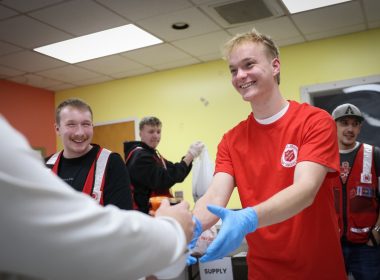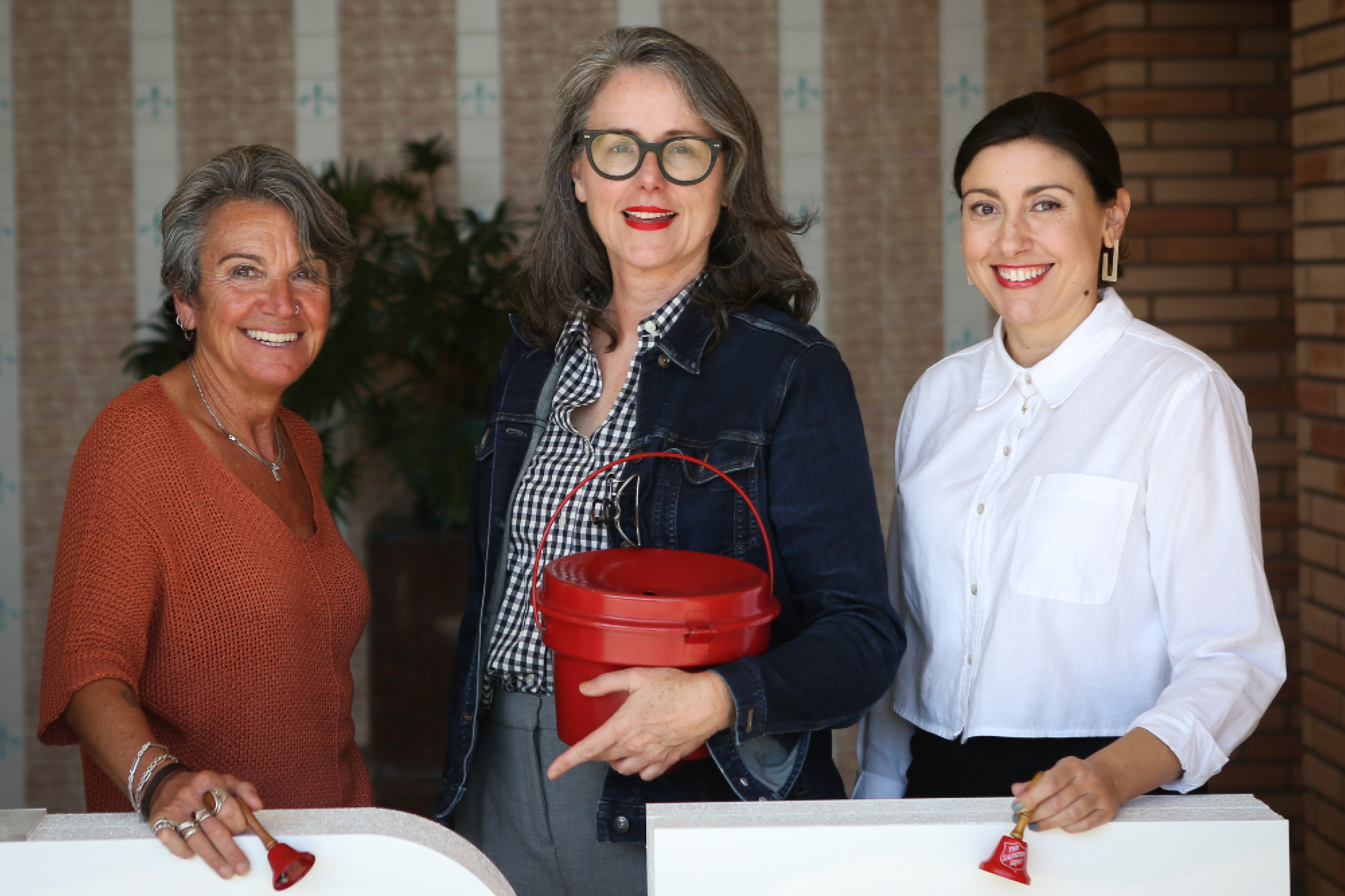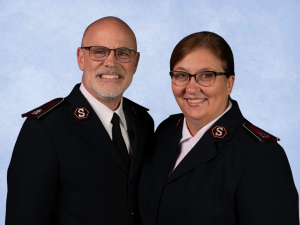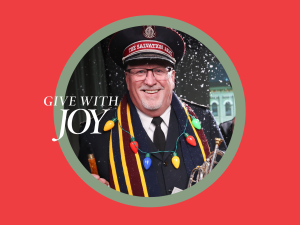Welcome back to the show and to the kickoff of the merriest time of year! And no, it’s not too early because Christmastime has already started in The Salvation Army. Yes, The Salvation Army is hard at work to make the holiday season a little brighter.
Of course, most people know us for our Red Kettles, our Angel Trees, and our strong presence during the Christmas season—but we support local families all throughout the year.
The donations we collect in those red kettles during the holiday season not only help us provide gifts to children who would otherwise go without, but they also help us provide food, shelter and utility assistance to those who need it most every day of the year.
In essence, it’s a critical time for The Salvation Army and a busy one, too.
On the show today, I’m joined by members of the Western Territory’s Community Relations and Development Department: Director of Communications and Brand Management Deb Knutson, Public Affairs and Communications Manager Kathy Lovin and Territorial Director of Corporate Engagement Maria Todaro.
They’re entrenched in the Christmas effort and here to share more about how every dollar dropped into a red kettle helps give local families the Christmases they deserve and the yearlong support they need.
There’s plenty of ways to get involved, whether you put a present under someone’s tree today or help keep a roof over someone’s head tomorrow. Whether you want to help brighten Christmas morning or the hardest nights for hardworking families, you can help us carry the spirit of Christmas throughout the year.
Show highlights include:
- How The Salvation Army became a part of the Christmas season.
- The purpose of the red kettle and what it stands for.
- How The Salvation Army differs from other charitable organizations.
- The meaning behind the Love Beyond campaign.
- The process of setting up a red kettle outside of a store.
- How you can get involved as a bell ringer.
- Ways The Salvation Army assists families during Christmastime and throughout the year.
- The importance of Christmastime at The Salvation Army.
Listen and subscribe to the Do Gooders Podcast now. Below is a transcript of the episode, edited for readability. For more information on the people and ideas in the episode, see the links at the bottom of this post.
* * *
Christin Thieme: Well, Deb, Maria and Kathy, welcome to the Do Gooders Podcast.
Kathy Lovin: Thank you.
Christin Thieme: Thanks for being here. It’s only early November, I realize, but for The Salvation Army, Christmas starts very early. Actually, before now we’ve been in Christmas mode. It’s a busy time of year for The Salvation Army, but a fun one and not just us. I also have been out and seen Christmas decorations for sale already, so it’s not just us that kicks things off early, but The Salvation Army especially is really well recognized across the country at Christmastime. How do you think the organization has become such a part of the season?
Kathy Lovin: Yeah, I’ll answer that one. There’s a lot of reasons. Obviously, The Salvation Army being the Christian organization embraces the Christmas story, the story of the original Christmas and the peace and joy that Jesus brings. That’s a big motivator for us. But I do think I’m a big fan of those red kettles. People who work with me know that I am clinging tightly to the traditional red kettle. And I have to say, I think the kettles are kind of like a kryptonite, honestly, this really powerful thing that we have that other people just don’t have and every other nonprofit would love to have. I say that not having worked at other nonprofits, but nevertheless, I really think that red kettles are so iconic for Christmastime that this is almost our ace in the hole… And I think that the kettles are huge because they’re a face-to-face, passive fundraising opportunity for folks.
We stand outside stores. We don’t say, “Come on over here and put some money in the kettle.” We just say “Happy Holidays, Merry Christmas.” We give people the opportunity to do good, and I think it’s an opportunity for people to give no matter how much they can afford, right? We count up every quarter, every dollar, every $20 bill, and it all matters. It all goes into that community where the money is raised to do good, and I think it gives people peace to know that no matter what they give, they’re helping somebody that struggles with the bottom line in their community, somebody who’s struggling with poverty. I think that it’s also a great teacher. Those kettles are often the first way somebody gets involved in philanthropy. Parents teach doing good and philanthropy at the kettle a lot of times. We hear it every year.
Christin Thieme: Yeah, all those little piggy banks kids bring to drop in. So cute. Well, like you said, it’s really an iconic part of Christmas, and we were looking just recently at a list of all of the movies that The Salvation Army kettle, the red kettle has been in through the years, and it was over 100 different movies that we’re represented in, so it really is an iconic part of Christmas. I’m sure most people listening have seen the red kettle out there in their community at some point during Christmas, but for those who maybe aren’t as familiar, maybe they’ve seen it and don’t really understand what it is and what it does—could you give us a little primer? You touched on it a bit there, Kathy, but maybe a Kettle 101 here for somebody who has seen it but maybe doesn’t really understand what it stands for, what exactly is the red kettle? What does it do?
Deborah Knutson: Sure. Yeah, I’ll take that one. Since I’ve been around almost as long as the kettle in The Salvation Army, so I’ll do this one. The Army actually introduced the tradition of giving through the red kettle more than 130 years ago. It all started back in December of 1891 in San Francisco, and there was a young Salvation Army officer named Joseph McFee. He was a captain. And he wanted to provide a free Christmas dinner to the hungry people in the city. He was trying to figure out how he was going to fund that.
He remembered as a young man, as a sailor in Liverpool, England, seeing a Simpson’s pot, and that was placed on the stage landing where people passing by would toss spare change in to help local people and families in need. So Captain McFee got permission to place a similar pot at the Oakland Ferry landing there at the foot of Market Street in San Francisco, and the tradition of giving through the red kettle was born then. And here we are, what, 132 years later. Last year, people across the U.S. gave more than $100 million dollars through our red kettles here in the US, which helped us make Christmas a lot brighter for about 2.2 million people.
Christin Thieme: Incredible.
Deborah Knutson: That’s what the kettle does in your community and the dollars stay local. Kathy touched on that. You put dollars in the kettle, those dollars stay local, and they help the folks in that community who are in need, ideally Christmastime and ideally throughout the year.
Christin Thieme: Yeah, that’s amazing—$100 million dollars in just a few weeks. It’s incredible. Thank you to everybody who gives to the kettle. So beyond the kettle, we see that in our communities and we’re asking people to help us to join in and join with us. What are The Salvation Army’s Christmas efforts in communities everywhere across America? What are we doing at Christmastime and how do we differ from other organizations who are also asking for support at this time of year?
Maria Todaro: Yeah, at Christmastime, I think something that’s pretty consistent in every community is that we’re providing toys and food to families. The way that that manifests itself or shows up in each community might be a little bit different, but we do have some signature programs, not just the red kettle. We also have, hopefully a lot of people have heard of the Angel Tree program. The Angel Tree is mostly supported by businesses and organizations, and basically it exists to be sure that children have a toy that they’ve wished for under the tree on Christmas morning. So local Salvation Army programs collect the child’s wishes from families during the intake process, and then they make ornament tags that have the child’s name and age range and types of toys that they would really like to have their interests if they like Pokemon or whatever they love.
And then people can take the tag off the tree and by people I’m saying if it’s a business, it can be their customers, employees, it could be visitors, it could be parishioners if it’s another church and they can shop for the child and bring that specific toy back for that specific child, put it in the collection bin, and then The Salvation Army makes sure that that child gets that toy. It’s an awesome program. We have so many business partners that love doing that year after year. When it comes to individuals and family groups, also businesses that want to support a whole family. We have the Adopt a Family Program. That’s where during that intake process, we really earmark the families that have the most challenging life circumstances to make sure that we can really rally around them and not only help the kids with toys, but also help the family with household items and things that we might consider simple, but that are a huge deal to these families.
And so you as a group can adopt a family and you get a list of all of that family’s needs, you get their clothing sizes, household items that would be a huge blessing to them, and the ages and the types of toys that the kids would like. And as a group, we do it at territorial headquarters—our community relations team adopts a family. We get our list, we shop for the whole family, and then you bring the whole bundle back to The Salvation Army program, and they make sure that the family gets that bundle. And it’s a really big deal for those families, and it’s an awesome program. We also just have businesses and organizations that do general toy drives and food drives for us because during the Christmas season, we provide food boxes with holiday meal staples and gift cards to supplement so that families can purchase specific items to make family recipes and food drives help to make that possible.
General toy drives help us to stock our Toy and Joy gift shops where families can come in and shop for their children, which really provides a dignified process where the parent feels like they are providing Christmas for their child and they are selecting the gifts that their child gets, instead of just having a handout that there isn’t a personal touch associated with. So that program’s unreal, and we try and get as many of our volunteers and partners and supporters engaged in that in communities where those Toy and Joy gift shops exist because there’s just nothing like it. It’s just a beautiful experience that’ll stick with you forever.
And then every community has their own little partnerships based on different needs and resources in each community. Like for example, in Alaska, we do Operation Santa with the National Guard. Alaska has a lot of different really remote communities where they might not even have a toy store, they don’t have a Walmart or a Target, and it might be cost prohibitive for our donors to send toys to these remote areas because of the shipping costs. So we get toy donations, load up a helicopter or small plane with the National Guard and Salvation Army officers and volunteers. We go out to those areas and we bring Christmas to the kids in those areas. So that’s just one example of how every community sort of has different fun activations during Christmas.
Christin Thieme: Santa even comes along on those trips a lot of times. We did an episode with somebody, we’ll link to that, all about Operation Santa, if you want to hear more about it. It’s such a cool program. Love that one. As you’re talking, basically, there’s so many different ways to get involved in what The Salvation Army is doing at Christmas and in making Christmas fun and bright for families wherever you are. I think that’s what I love. Each of those programs is so fun in its own right and cool to be involved in. I know my extended family for years now has done the Adopt a Family where our family adopts a family and we make it part of our Christmas tradition. Everybody shops and then we plan a night, and it’s a big family dinner where we wrap all the presents and get them all ready to go for that family.
We’ve made it part of our tradition, which is something that it’s so simple and easy to do, and it makes it kind of a fun part of your own Christmas. So if you’re listening and want to be involved, there’s definitely room for you in all of these Christmas programs, basically. Bottom line. I know I’ve already seen an ad this year on TV for The Salvation Army at Christmas, which focuses on Love Beyond. Can you share a little bit about the meaning behind this campaign?
Deborah Knutson: Sure, sure. Well, first of all, I’m glad you’ve seen the ad. That’s a good thing. Always happy to hear that. Yeah, Love Beyond is a campaign we launched a couple of years ago, and it’s all about love. It’s about love for all and for always and love beyond difficult situations and challenges like despair, loneliness, hunger, beyond barriers and differences that sometimes make it challenging to meet the need, and beyond points in time like Christmas. I’m hoping that’s the ad you saw. And more importantly, it’s an invitation to people too, above all and beyond all, love others. It’s a big job and it’s a job year round and lifelong. So we invite people to join that.
Christin Thieme: Absolutely. It doesn’t end at Christmas. So we talked about all these ways that The Salvation Army really is at work at Christmastime, one of the big ones, as we mentioned, being the kettle. I’m wondering if you can share a little bit about the behind the scenes of that, because I imagine that we don’t just show up and place kettles outside of stores across America. What goes into those partnerships?
Deborah Knutson: Sure. Yeah, it really varies quite a bit from rural areas to more metropolitan areas, from mom and pop type establishments to major retailers. And some are based on a conversation over a cup of coffee, and some are formalized agreements. But what they all have in common, what they all begin with is a mutual concern and compassion for, and a commitment to do something to help others. So they all take different forms and come together in different ways, but that’s what they’re all based on.
Christin Thieme: I love it. So we’ve talked about all these different ways. We’re always looking for volunteers to help join in. How can someone get involved in ringing the bell or however they might want to be more involved in what The Salvation Army is doing at Christmas? Where would you direct someone?
Kathy Lovin: Let me try and answer that one. I think for kettles, I would start with people who might be in mall management or maybe they own a store or an event space, and they would like to have kettles to enhance their Christmas programs for that space. We would love for folks to volunteer for that. I mean, we think more kettle sites just means more money to help people who are struggling in their community.
So I would love this to be a call-out for anybody who has a store or a mall or an event space. But if you’re really looking to volunteer yourself or your club at school or maybe your church group, the best way to do that is through our Facebook pages. The Salvation Army doesn’t have one big volunteer program or platform online that folks can access. We are pretty decentralized in a lot of ways. And so the best way to do that is if you live in San Bernardino, you should go to The Salvation Army San Bernardino Facebook page and look at what they’re promoting.
They’re going to tell you when they need volunteers to do bell ringing or when they are looking for families to adopt, other families who are struggling at Christmas. So I would start with the Facebook page, but you can also go to our website and use the zip code finder, put in your zip code, and then it’ll tell you what units are close to you. You can give them a call. We include the address and phone number on our website of every Salvation Army unit. I think that’s probably the best way to do it. And then once you hear back from somebody, they’ll hold orientation sessions for bell ringers. They’ll teach you, what do you need to do? Here’s an apron that you wear that distinguishes you as an official bell ringer, and they’ll just get you ready for the season and you can learn the ins and outs.
Christin Thieme: Love it. And then beyond the kettle and Angel Tree and Adopt a Family and our toy and food drives, what are other ways that we partner with companies, even broader organizations at Christmas and throughout the year?
Maria Todaro: Yeah, I think we’ve hit a lot of what we do with partners during Christmas, but sometimes with the Red Kettle campaign, retailers have non-solicitation policies and may not be able to allow our bell ringers outside of their stores, but they still want to support The Salvation Army. And in those cases, we’ve worked with them to create custom register campaigns where their associates are asking each customer at checkout to give on top of their payment to a donation to The Salvation Army. That could be a roundup campaign. It could be programmed into the pin pad. It could be a paper pinup that they then scan. There’s all different ways that we can go about that, and we have some really nice materials to help promote those types of campaigns. So that’s kind of an alternative that we do at Christmas.
When it comes to year-round, I think our approach to corporate partnerships is more of an art than a science. We really want to build long-term relationships with our partners, which means we need to really get to know them. We need to learn the issues that they’re facing as a company. We need to understand the impact that they want to make on the world, the resources that they can bring to the table. And then we sort of start putting that puzzle together to see how those components plug into our programs, campaigns and needs, and come up with a partnership that’s really mutually beneficial.
I would say some of our most impactful partnerships are the ones that involve people at all levels of a company and their customer base in a variety of interactions, not just one thing, but maybe they’re doing an employee volunteer day. And we’re also, if they’re a retailer doing a customer donation program, or we’re engaging some C-suite executives in joining one of our advisory boards, or we’re engaging with their foundation on an impactful grant to support a program and in turn providing impact information that they can share with shareholders and employees. So yeah, there are so many different ways that we partner and we like to really customize and tailor each partnership to the partner.
Christin Thieme: Yeah, absolutely. And we would love to involve you.
Maria Todaro: Yes, we would.
Christin Thieme: So finally, to kind of wrap it all up, if you had to summarize everything, why is Christmastime so critical for The Salvation Army, and what do you hope to see this year especially?
Deborah Knutson: Wow. There will always be need. Need knows no season, as a matter of fact. But it seems to be greater and more immediate during the holiday season.
Christin Thieme: Yeah, definitely.
Kathy Lovin: And it’s more obvious, you know what I mean? If you are a parent and you can’t afford Christmas gifts, it just feels more painful during the holiday season. This is probably why we activate in the way that we do, because the fourth quarter of the calendar year is busy for every charity, right? We’re not the only ones, but since we activate at Christmastime in such a major way, there is an urgency to it. There’s a big urgency to it.
And truthfully, our local units in the field, correct me if I don’t have the statistic correct, but I believe they raise about half of the money they spend for the whole rest of the year during this final quarter of the calendar year, because it’s a big fundraising season. And it is also a big season for the Army’s spending too, because we spend a lot of it during this final quarter to help people with their Thanksgiving and Christmas to make both holidays bright. So it’s a big deal for us.
Maria Todaro: Yeah, we hear from families all the time that say, if it wasn’t for The Salvation Army, we were between, do we pay the gas bill or do we buy toys for our child this Christmas? So it’s pretty critical at Christmastime. But the money raised at the kettles help to fund our mission throughout the year. And we’re kind of dealing with a difficult equation right now, because last year we saw funds at the kettles decrease for the third year in a row. We were down about 19 percent from 2019. And as everybody’s well aware, in that same time period, we’ve seen historic increases in need, the pandemic, world events, inflation, and that need is not going anywhere.
So you see funding decreasing, need increasing, and that’s a challenging equation. So we really need community support so we can continue to rally alongside our neighbors and provide food, shelter, emergency assistance, rehabilitation, not just toys and holiday meals, but other vital services that keep people nourished and housed and whole and hopeful all throughout the year. So it is a critical time.
Christin Thieme: Absolutely. Well, thank you each. Thank you for sharing with us and for hopefully getting more people involved in what we’re doing at Christmastime and throughout the year.
Kathy Lovin: Thank you
Deborah Knutson: Thank you for having us.
Kathy Lovin: Yes. This has been fun. It’s my favorite time of year.
Christin Thieme: I think there’s a song about that.
Kathy Lovin: Thank you.
Maria Todaro: Thank you.
Deborah Knutson: Thanks.
Additional resources:
- Did you know The Salvation Army served some 24 million Americans last year fighting hunger, homelessness, substance abuse and more? Where can you help? Take our quiz to find your cause and learn how you can join in today.
- You’ve probably seen the red kettles and thrift stores, and while we’re rightfully well known for both…The Salvation Army is so much more than red kettles and thrift stores. So who are we? What do we do? Where? Right this way for Salvation Army 101.
Listen and subscribe to the Do Gooders Podcast now.











